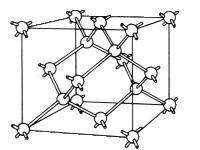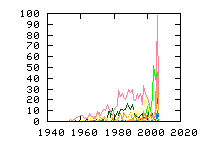« Previous
1
Next »
(13 hits, 1/1)
Showing
10, 25, 50, 100, 500, 1000, all papers per page.
Sort by:
last publication date,
older publication date,
last update date.
- 1. Appl. Phys. Lett. 88, 153518 (2006) , “Negative bias temperature instability mechanism: The role of molecular hydrogen”, Anand T. Krishnan, Srinivasan Chakravarthi, Paul Nicollian, Vijay Reddy, and Srikanth KrishnanThe role of dimerization of atomic hydrogen to give molecular hydrogen in determining negative bias temperature instability (NBTI) kinetics is explored analytically. The time dependency of NBTI involving molecular hydrogen was found to obey a power law with a slope of 1/6, as opposed to the 1/4... (Read more)
- 2. Appl. Phys. Lett. 88, 012101 (2006) , “The structure of the SiO2/Si(100) interface from a restraint-free search using computer simulations”, Dominik Fischer, Alessandro Curioni, Salomon Billeter, and Wanda AndreoniThe structure of the interface between SiO2 and Si(100) is investigated using the replica-exchange method driven by classical molecular dynamics simulations based on ab initio-derived interatomic potentials. Abrupt interfaces are shown to be unstable, whereas a substoichiometric... (Read more)
- 3. Microelectron. Reliability 46, 1 (2006) , “NBTI degradation: From physical mechanisms to modelling”,An overview of the evolution of transistor parameters under negative bias temperature instability stress conditions commonly observed in p-MOSFETs in recent technologies is presented. The physical mechanisms of the degradation as well as the different defects involved have been discussed according to a systematic set of experiments with different stress conditions. According to our findings, a physical model is proposed which could be used to more accurately predict the transistor degradation. Finally, based on our new present understanding, a new characterization methodology is proposed, which would open the way to a more accurate determination of parameter shifts and thus allowing implementing the degradation into design rules. (Read more)
- 4. Phys. Rev. B 73, 073302 (2006) , “Origin of Pb1 center at SiO2/Si(100) interface: First-principles calculations”, K. Kato, T. Yamasaki, T. UdaBased on first-principles calculations, we studied the generation behavior of Pb centers at SiO2/Si interfaces, especially for Pb1 centers, under oxidation of Si(100) surfaces. Pb1 centers were found to be formed... (Read more)
- 5. Microelectron. Reliability 45, 71 (2005) , “A comprehensive model of PMOS NBTI degradation ”,Negative bias temperature instability has become an important reliability concern for ultra-scaled Silicon IC technology with significant implications for both analog and digital circuit design. In this paper, we construct a comprehensive model for NBTI phenomena within the framework of the standard reaction–diffusion model. We demonstrate how to solve the reaction–diffusion equations in a way that emphasizes the physical aspects of the degradation process and allows easy generalization of the existing work. We also augment this basic reaction–diffusion model by including the temperature and field-dependence of the NBTI phenomena so that reliability projections can be made under arbitrary circuit operating conditions. (Read more)
- 6. J. Appl. Phys. 94, 1 (2003) , “Negative bias temperature instability: Road to cross in deep submicron silicon semiconductor manufacturing”,We present an overview of negative bias temperature instability (NBTI) commonly observed in p-channel metal–oxide–semiconductor field-effect transistors when stressed with negative gate voltages at elevated temperatures. We discuss the results of such stress on device and circuit... (Read more)
- 7. Phys. Rev. B 61, 8393-8403 (2000) , “Dissociation Kinetics of Hydrogen-Passivated Pb Defects at the (111)Si/SiO2 Interface”, A. Stesmans.An electron-spin-resonance study has been carried out, both isothermally and isochronically, of the recovery under vacuum annealing from the hydrogen passivated state (symbolized as HPb) of paramagnetic Pb centers (Si3?Si?) at the (111)Si/SiO2... (Read more)
- 8. Phys. Rev. Lett. 85, 2773-2776 (2000) , “Dangling Bond Defects at Si-SiO2 Interfaces: Atomic Structure of the Pb1 Center”, A. Stirling, A. Pasquarello, J.-C. Charlier, R. CarUsing a first-principles approach, we characterize dangling bond defects at Si-SiO2 interfaces by calculating hyperfine parameters for several relaxed structures. Interface models, in which defect Si atoms remain close to crystalline sites of the substrate upon relaxation, successfully... (Read more)
- 9. Phys. Rev. Lett. 83, 372 (1999) , “Hydrogen Electrochemistry and Stress-Induced Leakage Current in Silica”, Peter E. Bl?chl and James H. StathisHydrogen-related defects in oxygen-deficient silica, representing the material of a thermal gate oxide, are analyzed using first-principles calculations. Energetics and charge-state levels of oxygen vacancies, hydrogen, and their complexes in the silica framework are mapped out. The neutral hydrogen... (Read more)
- 10. Nature 396, 58-60 (1998) , “Interface structure between silicon and its oxide by first-principles molecular dynamics”, A. Pasquarello, M. S. Hybertsen, R. CarThe requirement for increasingly thin (<50 Å) insulating oxide layers in silicon-based electronic devices highlights the importance of characterizing the Si–SiO2 interface structure at the atomic scale. Such a characterization relies to a large extent on an understanding of the atomic-scale mechanisms that govern the oxidation process. The widely used Deal–Grove model invokes a two-step process in which oxygen first diffuses through the amorphous oxide network before attacking the silicon substrate, resulting in the formation of new oxide at the buried interface1. But it remains unclear how such a process can yield the observed near-perfect interface2, 3, 4, 5, 6, 7, 8, 9, 10, 11, 12. Here we use first-principles molecular dynamics13, 14, 15 to generate a model interface structure by simulating the oxidation of three silicon layers. The resulting structure reveals an unexpected excess of silicon atoms at the interface, yet shows no bonding defects. Changes in the bonding network near the interface occur during the simulation via transient exchange events wherein oxygen atoms are momentarily bonded to three silicon atoms — this mechanism enables the interface to evolve without leaving dangling bonds. (Read more)
- 11. Phys. Rev. B 38, 9674-9685 (1988) , “Hyperfine interactions in cluster models of the Pb defect center”, M. Cook, C. T. WhiteHyperfine interactions in the Pb center (denoted schematically as Si3?Si?) at the Si(111)/SiO2 interface have been studied with use of spin-polarized self-consistent multiple-scattering X? calculations on Si22H21/Si6O18... (Read more)
- 12. Phys. Rev. B 36, 9638-9648 (1987) , “Theory of the Pb center at the <111> Si/SiO2 interface”, A. H. EdwardsWe present a series of semiempirical calculations on threefold-coordinated silicon at the ?111? Si/SiO2 interface. These were performed on finite clusters of atoms with use of hydrogen terminators in an unrestricted Hartree-Fock formalism wherein we include lattice relaxations. We have... (Read more)
- 13. Phys. Rev. B 34, 3610-3619 (1986) , “Dipolar interactions between dangling bonds at the (111) Si-SiO2 interface”, K. L. Brower, T. J. HeadleyIn this paper a computational model is developed which allows one to calculate the contribution to the Zeeman linewidth arising from magnetic dipole-dipole interactions between unpaired electrons in the dilute limit, which in our specific application correspond to dangling bonds (Pb... (Read more)
« Previous
1
Next »
(13 hits, 1/1)
Showing
10, 25, 50, 100, 500, 1000, all papers per page.
Sort by:
last publication date,
older publication date,
last update date.
All papers (3399)
Updated at 2010-07-20 16:50:39
Updated at 2010-07-20 16:50:39
(view as: tree
,
cloud
)
| 1329 | untagged |
Materials
(111 tags)
Others(101 tags)
Technique
(46 tags)
Details
(591 tags)
Bond(35 tags)
Defect(interstitial)(18 tags)
Defect(vacancy)(15 tags)
Defect-type(19 tags)
Element(65 tags)
Energy(8 tags)
Isotope(56 tags)
Label(303 tags)
Sample(17 tags)
Spin(8 tags)
Symmetry(15 tags)

